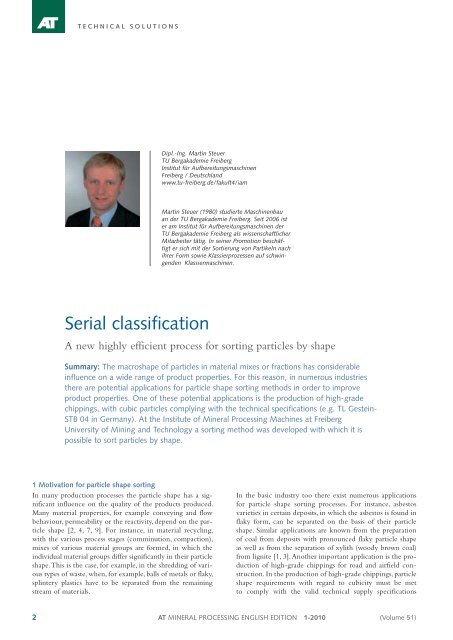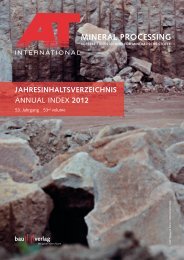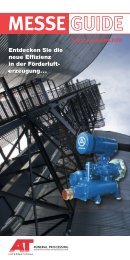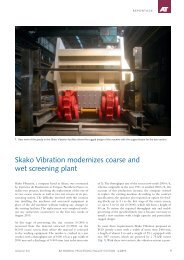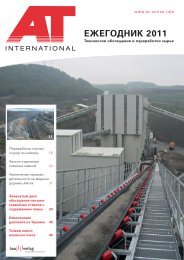Serial classification (1/2010) - Mineral Processing
Serial classification (1/2010) - Mineral Processing
Serial classification (1/2010) - Mineral Processing
You also want an ePaper? Increase the reach of your titles
YUMPU automatically turns print PDFs into web optimized ePapers that Google loves.
2<br />
TECHNICAL SOLUTIONS<br />
Dipl.-Ing. Martin Steuer<br />
TU Bergakademie Freiberg<br />
Institut für Aufbereitungsmaschinen<br />
Freiberg / Deutschland<br />
www.tu-freiberg.de/fakult4/iam<br />
<strong>Serial</strong> <strong>classification</strong><br />
Martin Steuer (1980) studierte Maschinenbau<br />
an der TU Bergakademie Freiberg. Seit 2006 ist<br />
er am Institut für Aufbereitungsmaschinen der<br />
TU Bergakademie Freiberg als wissenschaftlicher<br />
Mitarbeiter tätig. In seiner Promotion beschäftigt<br />
er sich mit der Sortierung von Partikeln nach<br />
ihrer Form sowie Klassierprozessen auf schwingenden<br />
Klassiermaschinen.<br />
A new highly efficient process for sorting particles by shape<br />
Summary: The macroshape of particles in material mixes or fractions has considerable<br />
influence on a wide range of product properties. For this reason, in numerous industries<br />
there are potential applications for particle shape sorting methods in order to improve<br />
product properties. One of these potential applications is the production of high-grade<br />
chippings, with cubic particles complying with the technical specifications (e.g. TL Gestein-<br />
STB 04 in Germany). At the Institute of <strong>Mineral</strong> <strong>Processing</strong> Machines at Freiberg<br />
University of Mining and Technology a sorting method was developed with which it is<br />
possible to sort particles by shape.<br />
1 Motivation for particle shape sorting<br />
In many production processes the particle shape has a significant<br />
influence on the quality of the products produced.<br />
Many material properties, for example conveying and flow<br />
behaviour, permeability or the reactivity, depend on the particle<br />
shape [2, 4, 7, 9]. For instance, in material recycling,<br />
with the various process stages (comminution, compaction),<br />
mixes of various material groups are formed, in which the<br />
individual material groups differ significantly in their particle<br />
shape. This is the case, for example, in the shredding of various<br />
types of waste, when, for example, balls of metals or flaky,<br />
splintery plastics have to be separated from the remaining<br />
stream of materials.<br />
In the basic industry too there exist numerous applications<br />
for particle shape sorting processes. For instance, asbestos<br />
varieties in certain deposits, in which the asbestos is found in<br />
flaky form, can be separated on the basis of their particle<br />
shape. Similar applications are known from the preparation<br />
of coal from deposits with pronounced flaky particle shape<br />
as well as from the separation of xylith (woody brown coal)<br />
from lignite [1, 3]. Another important application is the production<br />
of high-grade chippings for road and airfield construction.<br />
In the production of high-grade chippings, particle<br />
shape requirements with regard to cubicity must be met<br />
to comply with the valid technical supply specifications<br />
AT MINERAL PROCESSING ENGLISH EDITION 1-<strong>2010</strong> (Volume 51)
TECHNICAL SOLUTIONS<br />
Site of the development of new processes: the testing facility at the Institute of <strong>Mineral</strong> <strong>Processing</strong> Machines at Freiberg University of Mining and<br />
Technology<br />
(e. g. TL Gestein-STB 04 Technical Terms of Delivery for<br />
Aggregates used in Road Construction). Owing to changing<br />
deposit conditions (e. g. change in the microstructural texture)<br />
or comminution technology that is not optimally<br />
adjusted to the deposit conditions (e. g. comminution based<br />
on compressive stress for an anisotropic rock structure), an<br />
unacceptably high percentage of non-cubic particles may be<br />
found in the product grades.<br />
To minimize the percentage of non-cubic particles, currently<br />
multistage comminution systems are employed, in<br />
which either special short-head cone crushers, which produce<br />
cubic particles in the range of their gap width, or rotor<br />
centrifugal crushers, which operate with a size reduction<br />
ratio of « < 2, resultimg in a “re-cubicizing” or crushing of<br />
non-cubic particles. At the Institute of <strong>Mineral</strong> <strong>Processing</strong><br />
Machines at Freiberg University of Mining and Technology,<br />
a new type of process was developed in which in two spatially<br />
separated <strong>classification</strong> steps, where <strong>classification</strong> is<br />
performed based on different particle dimensions, the production<br />
of standard-compliant high-grade chippings is possible.<br />
In this process, non-cubic particles are separated from<br />
the quality fractions. The principle of the process of “double<br />
serial <strong>classification</strong>” of the high-grade chippings is explained<br />
in the following and described based on selected results. In a<br />
prepending study, particle shape is defined on basis of geometric<br />
particle dimensions.<br />
2 Definition of the particle shape with geometric<br />
particle dimensions<br />
In mineral processing, the group of geometric particle shape<br />
factors has proven a practicable method for the characterization<br />
of the particle shape. Geometric particle shape factors<br />
are formed with the use of defined particle dimensions<br />
(Fig. 1).<br />
These include:<br />
• Main dimensions (2D and 3D measurement),<br />
• Maximum dimensions (2D and 3D measurement) as well as<br />
• Statistical lengths (only 2D measurement).<br />
The main dimensions describe the edge lengths of a cuboid<br />
or rectangle enveloping the particle (3D) or the projected<br />
area of the particle (2D), a being the longest, b the mean and<br />
c the smallest main dimension. With use of the maximum<br />
(Volume 51) AT MINERAL PROCESSING ENGLISH EDITION 1-<strong>2010</strong> 3
4<br />
b<br />
TECHNICAL SOLUTIONS<br />
Main dimension<br />
(Example 3D)<br />
a<br />
dimensions, the longest chords standing vertically on top of<br />
each other of a projected area (2D) or a particle volume (3D)<br />
are used to describe the dimensions. Here X a corresponds to<br />
the longest maximum dimension, X b the mean maximum<br />
dimension and X c the smallest maximum dimension. Statistical<br />
lengths, such as the maximum chord X max as well as the<br />
Feret diameter X Fe are used exclusively for the description of<br />
the dimensions in the 2D range. The Feret diameter defines<br />
the distance between two tangents parallel to the direction<br />
of measurement, the maximum chord the longest chord<br />
within the particle in the direction of measurement.<br />
Depending on the method used, the particle shape is defined<br />
on the basis of the possibilities resulting in Table 1. A differentiation<br />
is made between elongation, cubicity and flakiness.<br />
For the production of high-grade chippings to meet the<br />
requirements of TL Gestein- STB 04, the geometric particle<br />
shape factor “cubicity” is crucial.<br />
3 Sorting by “double serial <strong>classification</strong>” of particles<br />
based on their shape<br />
The basic idea of the process of “double serial <strong>classification</strong>”<br />
is that with a temporally and spatially separated <strong>classification</strong>,<br />
it is possible to sort materials by particle shape on the basis<br />
of at least two different particle dimensions. For sorting by<br />
cubicity, as required for the production of standard-compliant<br />
aggregates in the non-metallic minerals industry, in a first<br />
<strong>classification</strong> step it is necessary to classify the material based<br />
on the particle length and in a second temporally and spatially<br />
<strong>classification</strong> step it is necessary to classify it based on<br />
the particle thickness. Fig. 2 shows this principle in simplified<br />
form as a black box model.<br />
For high sorting efficiency, very sharp <strong>classification</strong> processes<br />
are necessary. With an appropriate combination of particle<br />
movement and the geometry of the <strong>classification</strong> apertures,<br />
it is possible to define according to which particle dimension<br />
<strong>classification</strong> is performed. Precise adjustment of the particle<br />
movement also guarantees optimal separation sharpness in<br />
the individual <strong>classification</strong> stages. The particle movement is<br />
determined by the screen acceleration S V, which can be de -<br />
rived from the force acting on the individual particles<br />
(Fig. 3).<br />
Here:<br />
F a – force of acceleration in [N],<br />
F g – weight of the particle in [N],<br />
a – acceleration as a result of the vibration [m/s2],<br />
g – gravitational acceleration in [m/s2],<br />
Table 1: Selected particle shape factors on the basis of the main and maximum dimensions as well as the statistical lengths<br />
Particle shape<br />
Definition of the particle shape from the<br />
Main dimensions Maximum dimensions Statistical lengths<br />
Elongation CL = a<br />
b<br />
CL = Xa X b<br />
CL = Xmax X Fe<br />
Cubicity 1 CK = a<br />
c<br />
Flakiness 1 (Flatness) CP = b<br />
c<br />
1 Only possible with the use of three-dimensional measurement<br />
c<br />
X b<br />
Maximum dimension<br />
(Example 2D)<br />
.<br />
X a<br />
C K = X a<br />
X c<br />
C P = X b<br />
X c<br />
Statistical lengths<br />
(Example 2D)<br />
Measurement direction<br />
The following applies: a > b > c; a ⊥ b ⊥ c The following applies: X a > X b ; X a ⊥ X b The following applies: X max ⊥ X Fe<br />
1 Definition of the particle dimensions<br />
X max<br />
AT MINERAL PROCESSING ENGLISH EDITION 1-<strong>2010</strong> (Volume 51)<br />
–<br />
–<br />
X Fe
Feed<br />
1st screening step 2nd screening step<br />
Adjustment of particle<br />
movement and geometry<br />
of openings<br />
Screening for:<br />
Particle length<br />
With spatiotemporal<br />
partition<br />
Adjustment of particle<br />
movement and geometry<br />
of openings<br />
Screening for:<br />
Particle thickness<br />
2 Black box scheme of “double serial <strong>classification</strong>”<br />
cubic<br />
Product<br />
Sorting by cubicity<br />
Non-cubic<br />
Product<br />
a – angle of incidence of the screening surface in [°] and<br />
b – angle of incidence of the vibrating drive in [°].<br />
As a result of the effect of the acceleration on the particle, a<br />
characteristic particle movement results, which can be<br />
described as a function of the screen acceleration S V as a<br />
throw movement at S v > 1 or as a sliding movement at<br />
S v < 1. The transition from sliding to throw movement is<br />
fluent so that a differentiation can be made between very flat<br />
to very steep throws. In the selection of the <strong>classification</strong><br />
geometry a differentiation can be made between aperture<br />
geometries with the same dimensions in the X and Y directions<br />
and <strong>classification</strong> geometries with different dimensions<br />
in the X and Y directions. Fig. 4 shows a selection of various<br />
aperture geometries.<br />
For sorting by cubicity with application of “double serial<br />
<strong>classification</strong>”, circular apertures and rectangular geometries<br />
in the form of perforated plates and bar screens are used. If<br />
circular aperture geometries as well as a flat throw movement<br />
of the particles are used for <strong>classification</strong>, particles can be<br />
classified by their length. If <strong>classification</strong> is performed on a<br />
bar screen, with a flat throw motion, the particles orient<br />
themselves with their longest dimension (X a) parallel to the<br />
bars of the bar screen and are classified by the particle thickness.<br />
Fig. 5 shows the movement of non-cubic particles on<br />
the described aperture geometries with a sliding motion as a<br />
single-particle model.<br />
For the design of a machine suitable for industrial application<br />
in the non-metallic minerals industry for the production<br />
of standard-compliant high-grade chippings (in compliance<br />
with the limit values for cubicity), it is necessary for<br />
economic reasons, to perform both <strong>classification</strong> steps in one<br />
machine. For this purpose, the aperture geometries of the<br />
first and second <strong>classification</strong> steps are installed spatially<br />
3 Forces at the single particle and the resulting particle movement<br />
TECHNICAL SOLUTIONS<br />
separated on a single deck. For processing a wide particle size<br />
range, several combined decks are arranged on top of each<br />
other. Fig. 5 shows the multiparticle model employed industrially<br />
for “double serial <strong>classification</strong>”.<br />
4 Selected sorting results<br />
To evaluate the results of “double serial <strong>classification</strong>”, an<br />
evaluation method adapted to the process was developed.<br />
Aim of the evaluation is to relate the results obtained in the<br />
tests to the sorting results achievable under ideal sorting<br />
conditions, i.e. to evaluate the degree to which ideal sorting<br />
is achieved. Ideal sorting is defined here as 100-% separation<br />
at a defined cut-point c K,Tr (step function as the separating<br />
function see Fig. 6).<br />
The separating criterion distribution model used for evaluation<br />
was developed on the basis of the washability curve<br />
model, which was used originally to evaluate the sortability<br />
of coal by density [8]. Using this model, it is possible to<br />
determine the particle shape factors that can be achieved<br />
under ideal sorting conditions. As a function of one fraction<br />
percentage Q 0(c K) e.g. of the cubic fraction, the ideal particle<br />
shape factors for the cubic and non-cubic fraction c K, K,<br />
ideal or c K, NK, ideal are determined (Fig. 7).<br />
The difference between the two values is termed the ideal<br />
particle shape difference ∆c ideal. From the particle shape factors<br />
(c K, K, real and. c K, NK, real) determined in the empirical tests<br />
for the cubic and non-cubic fractions, the real particle shape<br />
difference ∆c real is calculated. The degree to which ideal sorting<br />
is achieved is defined by the ratio of the real to the ideal<br />
particle shape difference and termed the relative sorting efficiency<br />
S rel.<br />
S rel = ∆c K,real = c K,NK,real – c K,K,real · 100 in [%]<br />
∆c K,ideal c K,NK,ideal – c K,K,ideal<br />
On the basis of two result presentations, the suitability of<br />
“double serial <strong>classification</strong>” is proven for use in the sorting<br />
of particles by cubicity.<br />
For determination of the particle shape, the method according<br />
to DIN EN 933-4 (particle shape slide gauge) and photooptical<br />
particle analysis (Haver CPA 4-2) were used. While<br />
W X = W Y<br />
W X = W Y<br />
(Volume 51) AT MINERAL PROCESSING ENGLISH EDITION 1-<strong>2010</strong> 5<br />
W XY<br />
W X<br />
W Y<br />
Y direction<br />
X direction<br />
W X<br />
W X<br />
W Y<br />
W Y<br />
4 Possible aperture geometries for use in “serial <strong>classification</strong>”
6<br />
TECHNICAL SOLUTIONS<br />
Xa<br />
1 2 1 Xc, 1 wy X c, 2<br />
w xy<br />
Single Partcile Model<br />
1st screening step 2nd screening step<br />
for particle length X a<br />
Geometry of screen opening: Hole plate<br />
Particle movement: Flat throw<br />
Feed<br />
System boundary<br />
Multiple Particle Model<br />
5 Single- and multi-particle model of “double serial <strong>classification</strong>“<br />
Q 0 (ψ K,Tr )<br />
P 0 (ψ K,Tr )<br />
Q (ψ ) [%] 0 K Q (ψ ) [%]<br />
0 K<br />
100<br />
100<br />
0<br />
ψ K,min<br />
ψ K,Tr<br />
ψ K,max<br />
cubic fraction<br />
non-cubic fraction<br />
separation function<br />
ψ K [-]<br />
ψ K,min<br />
6 Description of an ideal sorting by particle shape cubicity<br />
the 933-4 method for determining the particle shape determines<br />
the mass percentage SI of non-cubic particles (c K > 3)<br />
of a fraction, the photooptical particle analysis characterizes<br />
particles according to their length/width ratio c L. Stark and<br />
Müller [10] showed that for coarse aggregate grades a correlation<br />
between the mass percentage SI and the elongation<br />
c L after photooptical particle analysis exists with a coefficient<br />
of determination r2 = 0.85.<br />
Fig. 9 shows the results of a sorting test in which a disperse<br />
material fraction in the size range between 1 mm and<br />
25 mm was sorted. In a first <strong>classification</strong> step, the feed fraction<br />
is classified by length into nine sub-fractions.<br />
Granulometric analysis of the sub-fractions showed that the<br />
distribution parameter c L,50 at 50 % of the particle shape<br />
number distribution Q 0(c L) in the nine single fractions lay in<br />
the range between 1.3 and 1.5 (elongation). Approx. 70 % by<br />
number of the particles lay in the range of an elongation of<br />
1.1 to 2.0. Only approx. 1 to 3 % by number had an elonga-<br />
0<br />
ψ K,Tr<br />
ψ [-] K<br />
ψK,max P 0 (ψ K ) [%]<br />
for particle thickness X c<br />
Bar screen<br />
Flat throw<br />
100<br />
P 0 (ψ K,Tr )<br />
0<br />
Cubic fraction<br />
Non-cubic fraction<br />
Cubic fraction<br />
Non-cubic fraction<br />
Cubic fraction<br />
Non-cubic fraction<br />
ideal –theoretic separation result of:<br />
cubic fraction<br />
non-cubic fraction<br />
ψ K,min ψ K,m ψ K,max<br />
ψ K,K,ideal<br />
ψ K,NK,ideal<br />
tion higher than 3 (Fig. 8). To sum up, it can therefore be<br />
formulated that this feed material consists of a very narrow<br />
particle shape number distribution Q 0(c L). In a second classifying<br />
step, the nine fractions are classified by particle thickness.<br />
As a result of the second classifying step, real particle shape<br />
differences between 0.1 and 0.21 could be achieved for the<br />
various fractions. This corresponds to a relative sorting efficiency<br />
in the range between 35 % and 85 %. Using the correlation<br />
between the mass percentage SI of the non-cubic<br />
AT MINERAL PROCESSING ENGLISH EDITION 1-<strong>2010</strong> (Volume 51)<br />
ψ K [-]<br />
7 Separation criterion distribution model for determining the ideal<br />
particle shape characteristic values
particle shape number distribution<br />
Q (ψ ) [%]<br />
0 L<br />
100<br />
90<br />
80<br />
70<br />
60<br />
50<br />
40<br />
30<br />
20<br />
10<br />
0<br />
1 1,25 1,5 1,75 2 2,25 2,5 2,75 3 3,25<br />
8 Example of a narrowly distributed particle shape number distribution<br />
(photooptical measurement)<br />
ψ L [-]<br />
particles and the length/width ratio c L after CPA analysis<br />
determined by Stark and Müller, particle shape differences of<br />
0.1 to 0.2 correspond to a difference in the mass percentage<br />
a<br />
b<br />
10 Diagram of the cubic (a) and non-cubic fraction<br />
(b) of a sorted gravel fraction 4/8 mm<br />
TECHNICAL SOLUTIONS<br />
of non-cubic particles between 10 % and 20 %. From this, it<br />
can be concluded that highly efficient sorting by cubicity in<br />
the studied particle size range is possible with “double serial<br />
<strong>classification</strong>”.<br />
In a second sorting test, the applicability of “double serial<br />
<strong>classification</strong>” by cubicity for the production of high-grade<br />
chippings in the non-metallic minerals industry was to be<br />
proven. For this purpose, a length-classified 4/8-mm gravel<br />
fraction was sorted by cubicity in a second <strong>classification</strong> step.<br />
Fig. 10 shows the graphic diagrams for the non-cubic and<br />
cubic fractions produced. Feed material, cubic and noncubic<br />
fraction were analysed both after DIN 933-4 as well as<br />
with photooptical particle analysis (Haver CPA4-2). Fig. 11<br />
shows the results obtained. In the feed fraction, a content of<br />
approx. 10 mass % non-cubic particles could be determined.<br />
According to photooptical particle analysis, this corresponds<br />
to a particle shape characteristic c L of 1.51. After a second<br />
classifying step was performed, in which an approx. 75-%<br />
mass yield was ob tained in the cubic fraction, there remained<br />
approx. 2 mass % of non-cubic particles with a particle shape<br />
factor c L = 1.48. The non-cubic fraction had a mass percentage<br />
of non-cubic particles of approx. 21 %. This corresponds<br />
to a particle shape factor c L ≈ 1.60. Accordingly, it could be<br />
shown that the production of high-grade gravel fractions is<br />
possible.<br />
(Volume 51) AT MINERAL PROCESSING ENGLISH EDITION 1-<strong>2010</strong> 7<br />
particle shape difference<br />
real [-]<br />
0,250<br />
0,225<br />
0,200<br />
0,175<br />
0,150<br />
0,125<br />
0,100<br />
0,075<br />
0,050<br />
0,025<br />
L,50,aufg = 1,3 bis 1,5<br />
70Anz-% zw. L 1,1 and 2,0<br />
1 bis 3Anz-% L > 3<br />
0,000<br />
A B C D E F G H I<br />
fraction A to I X a,u/Xa,o [mm/mm]<br />
particle shape difference<br />
(size range: 1 to 25mm)<br />
separation grade<br />
9 Results of “double serial <strong>classification</strong>” of dispersed bulk solids<br />
(1/25 mm)<br />
particle shape parameter SI<br />
(by DIN 933-4)<br />
30<br />
25<br />
20<br />
15<br />
10<br />
5<br />
0<br />
feed cubic fraction non-cubic fraction<br />
SI after DIN 933-4 LYL<br />
after CPA analysis<br />
11 Results of the sorting of a 4/8-mm gravel fraction by cubicity<br />
100<br />
90<br />
80<br />
70<br />
60<br />
50<br />
40<br />
30<br />
20<br />
10<br />
0<br />
1,70<br />
1,65<br />
1,60<br />
1,55<br />
1,50<br />
1,45<br />
1,40<br />
Separation Grade<br />
Srel [%]<br />
particle shape factor L<br />
(CPA-Analysis)
8<br />
TECHNICAL SOLUTIONS<br />
With the help of “double serial <strong>classification</strong>”, it is also possible<br />
to sort by elongation or flakiness. If <strong>classification</strong> is<br />
performed according to three different particle definitions, it<br />
is possible, for example, to separate particles with two characteristic<br />
particle shapes from one material stream (e. g. noncubic,<br />
flaky from cubic, non-flaky particles).<br />
Literature<br />
[1] Bierbauer: Der deutsche Steinkohlebergbau Bd. IV, Aufbereitung<br />
der Steinkohle 1.Teil, Sonstige Sortierverfahren, Verlag Glückauf<br />
GmbH, Essen, 1960, S.312–319<br />
[2] Brücher, Martin; Bottlinger, Michael: Dreidimensionale Computer<br />
simulation zur Untersuchung von Partikelschüttungen aus<br />
unregelmäßig geformten Partikeln, Chemie Ingenieur Technik<br />
78/2006, Nr. 6<br />
[3] Feist, Georg: Vorstudien über Verfahren zur Xylitaushaltung und<br />
Xylitaufbereitung im Kombinat „Schwarze Pumpe“<br />
[4] Giese, A., Specht, E.: Einfluss der Kornform auf die Verbrennung<br />
von Kohlepartikeln mit gleichem Siebdurchmesser; VDI-Berichte<br />
Nr.1629, 2001<br />
[5] Hälbich, Walter: Sortierverfahren auf Grund von Kornform,<br />
Reibung und Elastizität, Mitteilung Nr.175 aus dem Institut für<br />
Aufbereitung der Bergakademie Freiberg, 19. Jg., Heft 1, 1967<br />
[6] Höffl, Karl: Zerkleinerungs- und Klassiermaschinen, Deutscher<br />
Verlag für Grundstoffindustrie, 1. Auflage, 1985, S.294<br />
[7] Kuyumcu, H.Z.; Petersson, E.; Rolf, L.: Untersuchungen zum<br />
Ein fluss der Zerkleinerungsmechanismen auf die Partikelform der<br />
Zer kleinerungsprodukte; Aufbereitungstechnik 46/2005, Nr. 11<br />
[8] Schubert, Heinrich: Aufbereitung fester mineralischer Rohstoffe<br />
Bd. I, Deutscher Verlag für Grundstoffindustrie, 4. Aufl., 1989, S. 54ff<br />
[9] Stachowiak, G.W.; Hamblin, M.G.: Description of the Shape of<br />
the Wear Particles Found in Tribological Systems, The University<br />
of Western Australia, Perth, Australia<br />
[10] Stark, Ursula; Müller, Anette: Korngröße und Kornform von<br />
Gesteins körnungen und ihr Potenzial für die Betonforschung,<br />
Beton, 9/2006, S. 390ff.<br />
AT MINERAL PROCESSING ENGLISH EDITION 1-<strong>2010</strong> (Volume 51)


